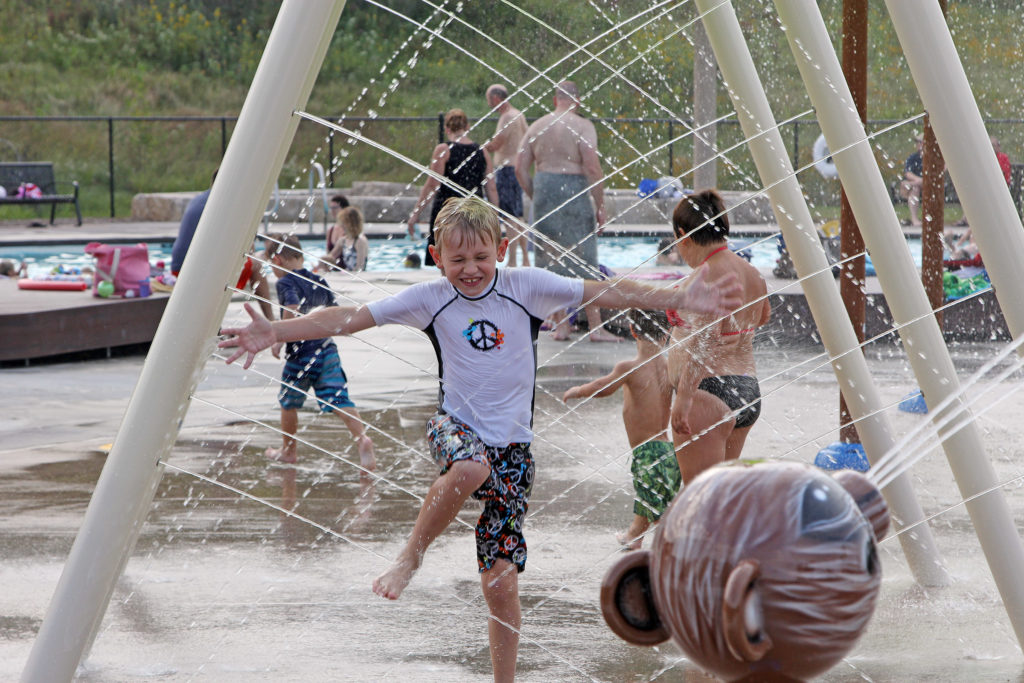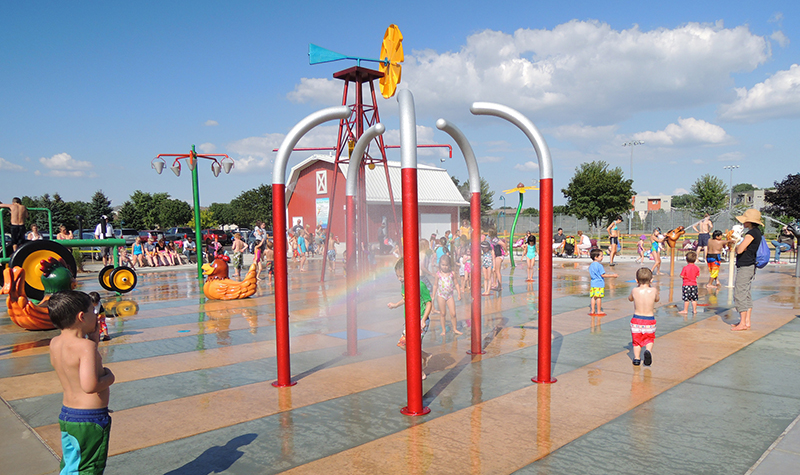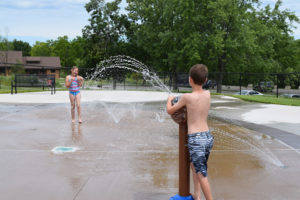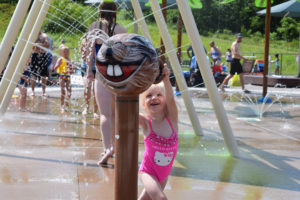Splashpads Hose Down Cost of Fun in the Sun

The hottest trend in parks and recreation across the U.S. is ironically known for its cooling effects. It seems like every park or green space is spontaneously springing a leak. But these “leaks” are actually carefully designed and often whimsically outfitted splashpads with colorful features that purposefully hold children’s interest. And because splashpads offer safe amusement, a splash of local identity, and low operational and maintenance costs, municipalities and even state parks are joining in the good, clean fun.
Splashpads consist of ground features in which water is sprayed from nozzles installed flush with the ground, as well as vertical features such as water cannons or sprays that are integrated into static features such as colorful animals, trees, or landforms. Because splashpads virtually eliminate drowning risks and require little staffing, many communities are replacing or supplementing their municipal pool facilities with splashpads.
Municipalities rarely fence in splashpads or charge entry fees for them. Municipal pools often charge fees, but that revenue commonly falls well short of covering pools’ much higher operational costs. The initial construction cost for a splashpad is also attractive, typically running between $200,000 and $1 million, as opposed to pools, which run more in the $4 million to $10 million range.
Splashpad maintenance is simple and depends on the type. A flow-through system involves draining the water to the municipal stormwater or wastewater collection and treatment system, in which case the only maintenance is occasionally removing any debris that could impede flow through the drains. A recirculation system is like a swimming pool in that the water used in the splashpad is drained to an on-site storage and treatment tank and then recirculated to the water features after treatment. This system requires daily maintenance but not a full-time on-site employee.

Thoughtful Design and Careful Sourcing
A good splashpad design firm is choosy about the manufacturers it works with to make sure its clients will be able to get replacement parts and service promptly in the years following construction. Manufacturers must also be selected carefully on the basis of their water features’ functionality and durability.
It is important for a design firm to provide a splashpad that is more than a conglomeration of mismatched out-of-the-box vertical features. A good designer will draw up features that tell the story of the splashpad’s location and then work with a full-service manufacturer that is equipped to custom-produce features according to those unique designs.
For Blue Mound State Park in Wisconsin, features include tents, pine trees, and a 17-foot-tall campfire. For the McKee Farms Park Splashpad in Fitchburg, Wisconsin, the former farmland-turned-park inspired a design that includes a barn-themed restroom building, colored concrete patterns that mimic traditional crop rows, and a mottled brown barnyard. The barnyard contains spraying flowers, horse-themed water cannons, and climbable chicken-shaped spray features. A large custom-designed tractor is situated among the crop rows, and the main vertical feature is a 21-foot-tall windmill with dumping buckets and variable spray patterns. (It’s an award-winner, too.)
One of the more creative vertical features we have conjured up is a skunk that would spray water from under its tail. Alas, that one never quite made it into production, as the client had second thoughts and opted to change that figure to the likeness of a badger.
We’re taking our services to the Southwest, so we’ll see what unique designs sprout up there. We’re in the early feasibility/location study phase of work for a City of Tempe, Arizona, splashpad.
 Designers employ creativity in how the splashpad features’ water flow is calibrated too, making it possible for children to discover that blocking the flow of water with their fingers in one location can increase the intensity of flow coming out of another spray nozzle nearby. Designing fun into a splashpad also can include setting up multiple water cannons within close range of each other so children can do battle with each other – or with Mom and Dad.
Designers employ creativity in how the splashpad features’ water flow is calibrated too, making it possible for children to discover that blocking the flow of water with their fingers in one location can increase the intensity of flow coming out of another spray nozzle nearby. Designing fun into a splashpad also can include setting up multiple water cannons within close range of each other so children can do battle with each other – or with Mom and Dad.
The Right Design for the Right Location
Splashpads are definitely not one-size-fits-all. One of our projects that is about to enter construction will serve as a splashpad during much of the daytime, but through color-changing LED lights, the facility will act as an architectural fountain at night, with colors dancing in the moving water as well as on a wall that will flank the splashpad. Precise planning of droplet sizes and other factors will also create a soothing aural experience for those enjoying the evening light show from a nearby seating area in the River Prairie development in Altoona, Wisconsin. Further extending this splashpad’s versatility is the fact that it will consist of only ground sprays (nozzles flush with the surface), which will give the City the option of turning off the spray at certain times, allowing the space to be used as a plaza.
Another design that we adapted to very specific local needs was a splashpad integrated into the shallow portion of a zero-depth entry pool in Champaign, Illinois.
A design we prepared for Moody Park in Milwaukee County that consists of easy-to-maintain brushed stainless steel creatively twisted into various loops and knots became so popular that it is now in a manufacturer’s worldwide catalog. Keep your eyes peeled for this feature when you’re in Dubai or some other far-flung place; you just might see it.
Safety First
 Safety is designed into every aspect of splashpads. A key feature is that splashpads are zero-depth, meaning water is immediately drained from the surface so that the risk of drowning is virtually eliminated. Tripping hazards are minimized by making sure features are either flush with the splashpad floor or rise a certain height above the floor in order to be obvious. Slipping hazards are minimized through nonslip concrete surfacing, achieved in part through certain brush patterns used during the finishing of the concrete pour. Splashpad features are designed with no sharp edges, and bolts and other fasteners are concealed or covered with rubber guards.
Safety is designed into every aspect of splashpads. A key feature is that splashpads are zero-depth, meaning water is immediately drained from the surface so that the risk of drowning is virtually eliminated. Tripping hazards are minimized by making sure features are either flush with the splashpad floor or rise a certain height above the floor in order to be obvious. Slipping hazards are minimized through nonslip concrete surfacing, achieved in part through certain brush patterns used during the finishing of the concrete pour. Splashpad features are designed with no sharp edges, and bolts and other fasteners are concealed or covered with rubber guards.
With the financial and safety advantages of splashpads, it’s no wonder municipalities are looking to create splashpads that deliver both fun and local identity.
Visit our landscape architecture page for more about the services we offer.
Comments
Have you ever done a stat on the operational cost of a pool vs splashpad
Our aquatics design team often assists clients with operational analysis of proposed system types including comparisons between traditional pools and splashpads. Please contact our landscape architects for more information.

Post a comment: